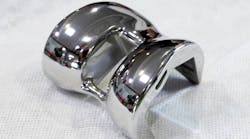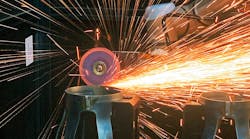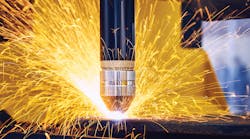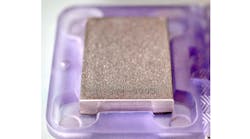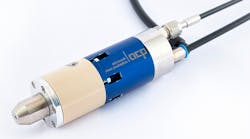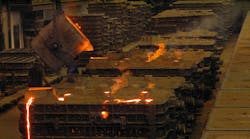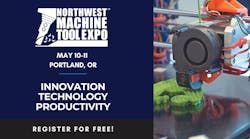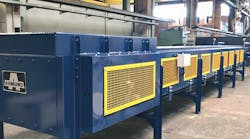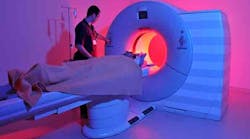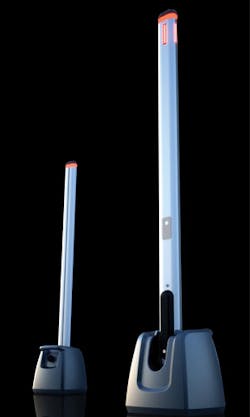Some engineering developments are so novel, so particular, that they seem somehow to have emerged from a single insight, a solitary breakthrough in design and engineering. Then, on closer inspection, it’s remarkable how frequently a cast metal product is part of the breakthrough.
Midas Pattern Co., a British manufacturer of high-quality molds, patterns, and tooling, played a critical role in supplying casting patterns for the commercial launch of a high-tech system that brings an additional level of performance and safety to magnetic resonance imaging. And while the product design has earned a prestigious award for the patternmaker, Midas also handled the finishing operation for the castings. But, let’s step back:
QinetiQ, a British defense technology developer, designed a system for fluxgate metal detection — the process of measuring the magnetization of a material, or measuring the strength and direction of a magnetic field — and it was this system that U.K. government officials were interested to adapt for commercial use.
A primary application was to be medical and research centers where magnetic resonance imaging is used. Ferromagnetic objects that pass through MRI doors can result in serious problems, like personal injury, unplanned MRI restarts, or damage to the MRI technology. Ferrous objects that reach the MRI magnet's fringe field can be drawn toward the magnetic core at great force, an occurrence that’s referred to a “the projectile effect.”
Serious projectile incidents have involved gas cylinders, chairs, respirators, IV poles, and smaller but still dangerous items, like scissors and medical/surgical instruments. In the U.K., records indicate 389 MRI-related events, including nine deaths, in the past 10 years.
Originally, QinetiQ’s ferromagnetic detection system was developed to locate submarines covertly. Unlike standard metal detectors, the Ferroguard does not generate a magnetic field but instead senses changes in magnetic flux in the space surrounding it. This allows the product to be very sensitive and easily tuned to look for different sizes of metal objects. More to the point, it means the device can be used close to hospital MRI scanners where traditional detectors often fail to operate because of the high-level of magnetic flux generated by the MRI.
To commercialize Ferroguard, QinetiQ launched a spin-off called Metrasens. However, bringing the commercial-scale version of the technology required a new product design — and thus through Britain’s Manufacturing Advisory Service, a business development agency, Metrasens was introduced to Smallfry, an industrial design and engineering firm.
“We were tasked with commercializing the product,” explained Smallfry managing director Steve May-Russell. “We applied contextual research, commercial objectives, and benefit mapping insights. We went to the audience to understand all of the stakeholders’ needs throughout the supply chain – after all, if you want to make sales you have to talk to the people with the money, the authority and the need.”
Having assembled that much detail on the development project, and with a PDR (product design requirements) brief, Smallfry and MAS set about identifying the appropriate suppliers. Midas and its capabilities were familiar to the engineering team, which simplified the choice of a manufacturer for the product’s base.
“It costs no more to tool a poor product than it does to tool a good product,” May-Russell recalled. “We knew Midas could achieve the levels of quality we were after. The pattern for the one-piece cast base was important – clearly it had to give good yield, but we were also seeking a good finish.”
Midas has been manufacturing precision pattern equipment and foundry tooling for over 25 years. The company also offers machining, and has numerous surface finishes, coating, and painting capabilities. For the Metrasens Ferroguard, Midas designed and produced the pattern equipment, outsourced the castings to a reliable foundry, and then performed the finishing steps that were appropriate to a high-tech device.
As the parts were destined for use in a medical setting, the surface finish and quality were additionally relevant. With sand castings, a typical foundry application would involve basic fettling and power coating. This is sufficient if the parts are commercial-grade and for general purposes, but in this case the objective was for the Ferroguard to appear just as high-tech as the design and application suggested. As a result, Midas undertook the final finishing and painted the parts to its own standards, taking an ordinary casting and elevating the presentation.
“Our experience allowed us to select the most appropriate manufacturing techniques and source suppliers to keep the product cost low, and at the same time to improve the assembly time and adjustability of the components for accurate set-up,” according to May-Russell.
“In the 12 months following the launch of the new version at a trade show, sales grew by 800%, of which 80% is exported,” he continued. “Furthermore, we removed 40% of the costs and reduced labor content by 60%. The product also won Best Industrial Product Design at the annual Design Week Awards.”
Thus, QinetiQ’s novel development, via the Smallfry’s design and engineering, and Midas Pattern’s prototyping and finishing expertise, emerged as the Metrasens metal detection technology known now as the Ferroguard MRI safety systems. Patients, staff, and equipment in MRI suites worldwide are safer, and the product is also successful in a number of civilian security applications — which is no so surprising after all.
